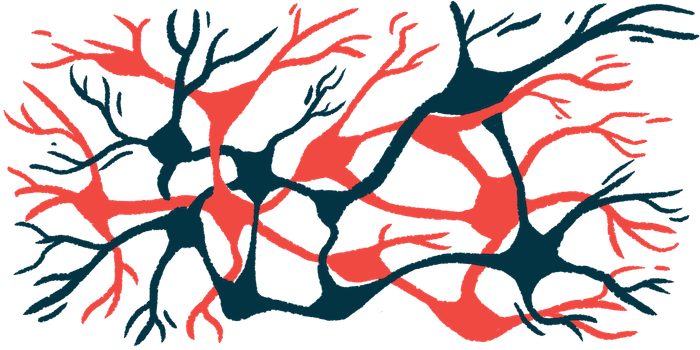Study uncovers previously unknown role of parkin in dopamine signaling
Discovery challenges common beliefs of what triggers Parkinson's

The parkin enzyme — whose loss is a known genetic risk factor of Parkinson’s disease — not only helps to regulate healthy activity of energy-generating mitochondria, but also plays critical roles in nerve cell communication, according to a study using patient-derived neurons.
Particularly, parkin loss resulted in defective recycling of signaling molecule-filled tiny vesicles at synapses, the point of near contact between nerve cells where electric and molecular signals are transmitted between nerve cells for communication.
This led to the accumulation of toxic forms of dopamine, the neurotransmitter, or chemical messenger, involved in neuronal communication, that is progressively lost in Parkinson’s.
The findings offer new insight into how mutations in both copies of the PRKN gene, which provides instructions for making parkin, are the most common cause of early-onset Parkinson’s. The discovery may open up new doors toward developing treatments for Parkinson’s associated with PRKN mutations.
“We showed that dopaminergic synapses become dysfunctional before neuronal death occurs,” Dimitri Krainc, MD, PhD, the study’s senior author at Northwestern University Feinberg School of Medicine, in Chicago, said in a press release.
“Based on these findings, we hypothesize that targeting dysfunctional synapses before the neurons are degenerated may represent a better therapeutic strategy,” added Krainc, who also is the director of the university’s Simpson Querrey Center for Neurogenetics.
The study, “Parkinson’s disease-linked parkin mutation disrupts recycling of synaptic vesicles in human dopaminergic neurons,” was published in Neuron.
Parkinson’s is characterized by the loss of dopamine-producing, or dopaminergic, neurons. Although its causes remain poorly understood, certain genetic mutations, such as those in the PRKN gene, can cause the neurodegenerative disease.
It has long been known that the parkin enzyme is involved in quality control of mitochondria (the cells’ powerhouses) by tagging damaged or defective mitochondria for degradation. Without a working version of parkin, damaged mitochondria can’t be cleared properly and they build up to toxic levels inside nerve cells, ultimately leading to the cells’ dysfunction.
Mutations in both copies of the PINK1 gene, which encodes an enzyme of the same name, also can cause Parkinson’s. The PINK1 enzyme is known to activate parkin to help in clearing damaged mitochondria. So, it long has been assumed that PRKN and PINK1 mutations can cause the disease because they disrupt the same cellular pathway.
Parkin is activated by another enzyme
However, Krainc’s team and colleagues have now showed that parkin is activated by another enzyme and is involved in other processes independent of PINK1.
The investigation started with two sisters, both of whom had Parkinson’s. One of the sisters developed disease symptoms in her 40s, but the other had disease onset decades earlier while still a teenager.
Genetic tests showed that both sisters carried disease-causing mutations in both copies of the PINK1 gene. The sister who was diagnosed at 16 years also had a mutation in one copy of the PRKN gene.
Usually, people with mutations in just one PRKN gene copy can still make some working parkin and don’t develop Parkinson’s.
“There must be a complete loss of Parkin to cause Parkinson’s disease. So, why did the sister with only a partial loss of Parkin get the disease more than 30 years earlier?” Krainc said.
Parkin key for synaptic vesicle recycling
To learn more, the scientists conducted a battery of tests in lab-grown dopaminergic neurons derived from each sister and a healthy control. They found that, in addition to its known mitochondrial quality control role, parkin also is key for a process called synaptic vesicle recycling.
In order to communicate with another neuron, a neuron will produce small vesicles filled with neurotransmitters like dopamine that release their content into the synapse when they reach the cellular membrane.
The neuron then undergoes synaptic vesicle recycling, which involves recovering the vesicle components from the cellular membrane and forming new synaptic vesicles that are ready to uptake neurotransmitters.
The researchers found that, when parkin is not working properly (one mutated PRKN gene copy), dopaminergic neurons are less able to recapture synaptic vesicles from the cellular membrane.
Notably, parkin’s role in synaptic vesicle recycling occurred independently of PINK1, but it was dependent on CaMK2, which activated parkin in a neuronal activity-dependent way. Parkin activation then promoted its recruitment to synaptic vesicles, helping to promote their recovery from the cellular membrane after neurotransmitter release.
Mutations in PRKN and SYNJ1 may share molecular mechanisms
This parkin role involved another enzyme called SYNJ1. Mutations in the gene that encodes SYNJ1 also are a known genetic cause of Parkinson’s, so the findings suggest that mutations in PRKN and SYNJ1 may share some molecular mechanisms.
Also, dysfunctional parkin caused a buildup of oxidized dopamine, a toxic form, inside neurons. Given that dopamine is readily oxidized when floating free inside a cell, synaptic vesicle recycling problems increase the likelihood of the molecule suffering toxic chemical modifications before being internalized into synaptic vesicles.
“We have identified a PINK1-independent function of parkin that has a clear linkage to deficits in dopaminergic dysfunction underlying the motor symptoms of [Parkinson’s disease],” the researchers wrote.
Mutations affecting parkin impair dopamine signaling
These findings imply that mutations affecting parkin have more far-reaching consequences than just messing up the mitochondrial quality control, and that they impair dopamine signaling even before any dopaminergic neurons have died.
“We discovered a new mechanism to activate Parkin in patient neurons,” Krainc said, adding that “now, we need to develop drugs that stimulate this pathway, correct synaptic dysfunction and hopefully prevent neuronal degeneration in Parkinson’s.”







